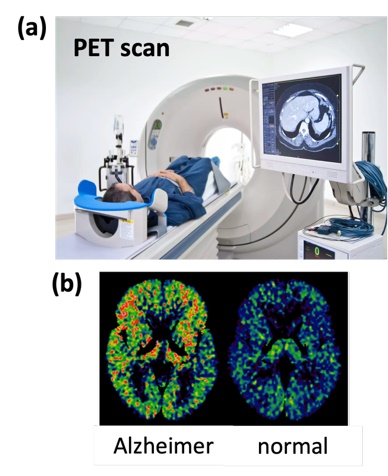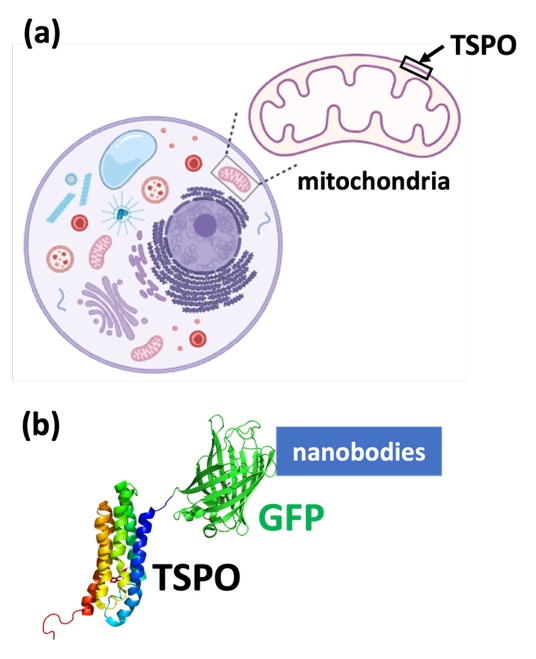-
Domain, Specialties : Biochemistry, Biophysics, Structural Biology
Keywords: membrane proteins, TSPO, expression systems, optical spectroscopy, X-ray and neutron scattering (SAXS/SANS)Research Unit : LLB/MMB
Summary
Membrane proteins lie at the heart of cellular life and represent nearly 60% of current therapeutic targets. Yet, they remain poorly characterized: barely 3% of the structures in the Protein Data Bank (PDB) correspond to them. Their study is therefore a major scientific challenge, especially when it comes to producing them in a native and functional form.
We are interested in TSPO, a small and intriguing mitochondrial membrane protein present in the nervous system. Its exact role remains debated, but TSPO is already a central player in neuroimaging, notably used in PET scans as a marker of brain inflammation associated with traumatic brain injury, cancer, and neurodegenerative diseases (e.g., Alzheimer’s, Parkinson’s) (Fig. 1).
Fig. 1. TSPO as a therapeutic target in neuroimaging. (a) Positron Emission Tomography (PET); (b) overexpression of TSPO in the brain of an Alzheimer’s patient.

Fig. 2. Production and purification of TSPO.
(a) Localization of TSPO in the outer mitochondrial membrane; (b) purification strategy based on the recognition of the fluorescent fusion protein GFP by “nanobodies.”A major challenge:
To obtain a clear vision of the structure/function relationship of TSPO in order to better understand its biological role and pave the way for new imaging and therapeutic tools.
Full description
👉 Objective 1: Produce TSPO in its native form
With the help of the ProtEx platform (I2BC, Saclay), we have already established proof of concept by expressing TSPO in native conditions in the yeast S. cerevisiae (Fig. 2). The internship will consist of optimizing this production and purification protocol, particularly in different environments (detergents, detergent/lipid mixtures, lipid nanodiscs)
👉 Objective 2: Explore its structure and function
The produced protein will be characterized using a range of biophysical and structural techniques:
- Optical spectroscopies (absorbance, fluorescence, circular dichroism),
- Light scattering (MALS, DLS/SLS),
- Small-angle X-ray and neutron scattering (SAXS at SOLEIL synchrotron, SANS at ILL Grenoble),
- Ligand-binding affinity measurements by microscale thermophoresis (MST).
The data obtained will allow comparison between the apo form and the ligand-bound form, to better understand binding and stability mechanisms.
References:
- Structure/function of mTSPO translocator in lipid :surfactant mixed micelles,
Saade C, Pozza A, Bonnete F, Finet S, Lutz-Bueno V, Tully MD, Varela PF, Lacapere JJ, Combet S. Enhanced, Biochimie 224, 3, 2024. - Effect of amphiphilic environment on the solution structure of mouse TSPO translocator protein,
Combet S, Bonneté F, Finet S, Pozza A, Saade C, Martel A, Koutsioubas A, Lacapère JJ. Biochimie 205, 61-72, 2023.
Location
The internship will take place at the Léon-Brillouin Laboratory (LLB, CEA, CNRS, Univ. Paris-Saclay), in collaboration with Dr. José Luis VAZQUEZ-IBAR at LPSM/I2BC, Univ. Paris-
Saclay, and Dr. Alexandre POZZA at LBPM/IBPC, Paris.Internship conditions
- Internship duration: 4 to 6 months
- Level of study: Bac+5
- Training: Master 2
- Continuation in PhD thesis: Yes
- Application deadline: December 2026, 19th
Experimental skills
Master 2 student in biophysics, biochemistry, or physical chemistry, curious and motivated by structural biology and membrane proteins. A PhD continuation may be considered at the end of the internship.
Language: French or English.
Links
- Web site of the laboratory : LLB/MMB
- Personal web page of the supervisor: Sophie Combet
- Detailed flyer of the internship subject
Internship Supervisor
Sophie COMBET
Tél. : +33 1 69 08 67 20
E-mail :
December 19 2025March 1 20264 month6 monthCEA Saclay, (91) Essonne, France -
Domain, Specialties : Liquid physics
Keywords: physics of materials, optics,Summary
It is generally accepted that the flow of a fluid in a channel does not result in any temperature variation (without an external heat source or without reaching extreme velocities). The density of the liquid is not expected to change under flow, and therefore neither is its temperature.
But the classical hydrodynamic law is no longer valid at the mesoscopic scale (< 1 mm). Our team has shown that liquids possess shear elasticity at small scales, a property known to be specific to solids. We have experimentally shown that when the liquid elasticity is stressed, the flow mechanism can lead to heating or cooling.
Full description
Elasticity is one of the oldest physical properties of condensed matter. It is expressed by a constant G of proportionality between the applied stress (σ) and the strain (γ): σ = G.γ (Hooke’s law). The absence of resistance to shear deformation (G’ = 0) indicates liquid-like behavior (Maxwell model). Long considered specific to solids, elasticity has recently been identified in liquids at the submillimeter scale [1].
The identification of shear elasticity (non-zero G’) at the small scale holds the promise of discovering new solid properties of liquids. Thus, while no temperature change is conventionally expected under flow, we show that this is no longer true at the small scale and identify the emergence, without an external thermal source, of a positive or negative variation in temperature depending on the applied conditions [2,3]. We will explore the thermal response of liquids and exploit this ability to convert mechanical energy into temperature variations within the framework of microhydrodynamics.
Finally, we will strengthen our collaborations with theoreticians, notably with A. Zaccone of the University of Milan.
This topic relates to properties related to wetting, thermal effects, and small-scale liquid transport.Références :
- “Explaining the low-frequency shear elasticity of confined liquids, A. Zaccone, K. Trachenko, PNAS, 117 (2020) 19653–19655. Doi:10.1073/pnas.2010787117.
- E. Kume, P. Baroni, L. Noirez, “Strain-induced violation of temperature uniformity in mesoscale liquids” Sci. Rep. 10 13340 (2020). Doi : 10.1038/s41598-020-69404-1.
- E. Kume, A. Zaccone, L. Noirez, « Unexpected Thermo-Elastic effects in Liquid Glycerol by Mechanical Deformation » Physics of Fluids, 33, 072007 (2021) Doi: 10.1063/5.0051587.
Location
CEA Saclay Center, France
Internship conditions
- Internship duration: 3 months
- Level of study: Bac+5
- Training: Master 2
- Continuation in PhD thesis: Yes
- Application deadline: 5 janvier 2026
Experimental skills
Language : English
Useful methods and technics:
microfluidics, infra-red, image treatmentComputer languages and software:
Home softwares, FIJILinks
- Web site of the laboratory : https://iramis.cea.fr/llb/nfmq/
- Personal Web page of supervisor : Laurence Noirez
Supervisor
Laurence NOIREZ (LLB/NFMQ)
Phone: 0169086300
Email :
January 30 2026February 2 20263 monthCEA Saclay, (91) Essonne, France




